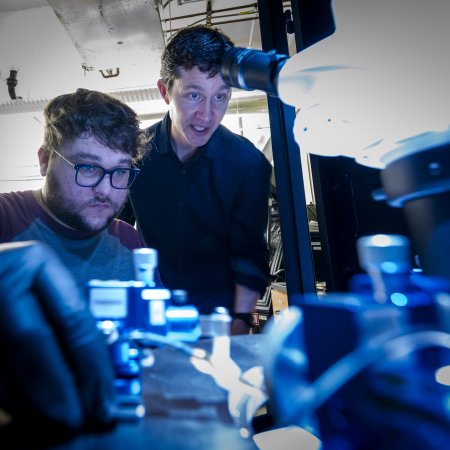Only in the first year of graduate school, Hubert has evinced a remarkable dedication for teaching and mentorship that goes beyond his responsibilities as a graduate student. His interest in teaching has also taken many forms, from lab and classroom instruction to curriculum development and training other students how to teach biology.
As an undergraduate, Hubert was a learning assistant in various biology courses and assisted with piloting the learning assistant program for the vertebrate biology course, which involved developing workshops and pedagogical materials, teaching peer-mentoring and working with course faculty to facilitate student learning in the course.
The learning assistant program in OSU, supported by a NSF grant, trains top undergraduate students to facilitate peer discussion and class activities in large lecture classes. The learning assistants circulate among students and foster in-class learning by providing individualized feedback as students grapple with complex questions posed by the instructor.
Hubert developed novel curricula for an introductory biology course at OSU. He eventually co-authored the laboratory module that was published in American Biology Teacher—a peer-refereed professional journal designed to support the teaching of K-16 biology and life science. Hubert currently teaches introductory biology courses as well as the upper division vertebrate biology course.
He volunteers in the classroom of the local juvenile detention center, where he works with teens to build their math and science skills. Hubert has also served as a mentor in the Mentoring Works! Program, helping at-risk middle school students transition into high school.
Perhaps his own teachers and mentors have something to do with his love for teaching. Hubert credits OSU biology lecturer, Lori Kayes and his advisor Robert Mason for serving as wonderful mentors and teachers, and being “instrumental in everything I have done.” Hubert was closely guided by Kayes in his role as a learning assistant for introductory biology courses during his undergraduate years at OSU.
A superbly taught vertebrate biology class by Mason planted the seeds for Hubert’s research project as well as fostered a love for the science of reptiles. When Mason offered him a spot in his lab for graduate research, Hubert didn’t hesitate to accept.
At OSU, Hubert found opportunities to do research on reproduction in salamanders in freshwater streams, behavioral work with crayfish, a study of coral growth and survival before finding his graduate research focus on terrestrial environments and garter snakes.
His award-winning NSF proposal “An Integrative View of Brumation in a Changing Environment” will employ molecular techniques to shed light on what genes are associated with hibernation (brumation) and investigate changes to allele frequencies, morphology and fecundity in populations of the common garter snake.
“My overall project is how the snakes survive sub-zero temperatures, and I am interested in a transcriptional level in how they are expressing their genes and how their genes are used in that huge block of time,” said Hubert.
Hubert will study the garter snakes in the world-famous snake caverns of the Interlake region of Manitoba, Canada. This is the site of an unrivaled biological phenomenon where tens of thousands of snakes hibernate for eight months in underground caves and emerge to engage in reproduction in the month of April.
Although the mating behavior among garter snakes is a well-studied phenomenon (Hubert’s advisor Mason has pioneered numerous studies on this model of garter snakes), Hubert’s research will investigate what happens during the distinct phase of brumation and how garter snakes respond to temperature changes as they transition from one life-cycle phase to another (brumation, breeding and feeding).
As it so happens, the effects of climate change in Manitoba have been particularly intense. The average heat increase in Manitoba has been twice the global average and the forecast is that Manitoba winters will be seven degrees warmer by mid-century. Its effects on garter snakes, whose life phases from hibernation to breeding are driven by temperature changes, are bound to be striking.
“Garter snakes are in a unique situation because they live in the northernmost parts of North America and experience extremes like no other species,” said Hubert.
His research will focus on the effects of climate change on garter snakes through genome-wide analyses and a study of the morphological traits and fecundity in the population over time.
From his maiden research trip to Manitoba with Mason and other researchers in April this year, Hubert will bring back garter snakes for hibernation in a temperature-controlled facility in an OSU lab for further study.
The father of 12-year-old and four-year-old boys, Hubert attributes his award to his unusual personal circumstances and their influence in making him the scientist he is today.
“When I dropped out of high school, I believed I didn’t have any other options, and it took me years of experiencing life and exploring different opportunities to understand that I could find success in higher education,” said Hubert.
A love for coral reefs and science
In the lab of her advisor Rebecca Vega Thurber, microbiology Ph.D. student Becca Maher studies how environmental stressors alter the coral host and its associated microbes. Maher, who graduated from Rice University in 2016, will soon be collaborating on a very interesting project in the Vega Thurber lab involving the study of coral microbiome at the Gump Research Station on Moorea, French Polynesia.
Maher will be traveling to Moorea this September for her first field season to conduct ecological experiments on the reef and microbial analyses along with a fellow scientist at UC Santa Barbara.
Her NSF project investigates how predation by parrotfish and elevated nutrient levels combine to affect coral microbiome and increase the rate of coral death.
"My project is exciting because we are investigating a phenomenon that has never been observed before."
"Herbivores that supplement their diets by predating coral are usually benign to the coral in healthy reef systems. However, many reefs around the world are facing nutrient pollution from terrestrial sources like agricultural runoff. And when the water is enriched with nutrients, corals can no longer recover from fish predation, leading to total colony mortality," explained Maher.







